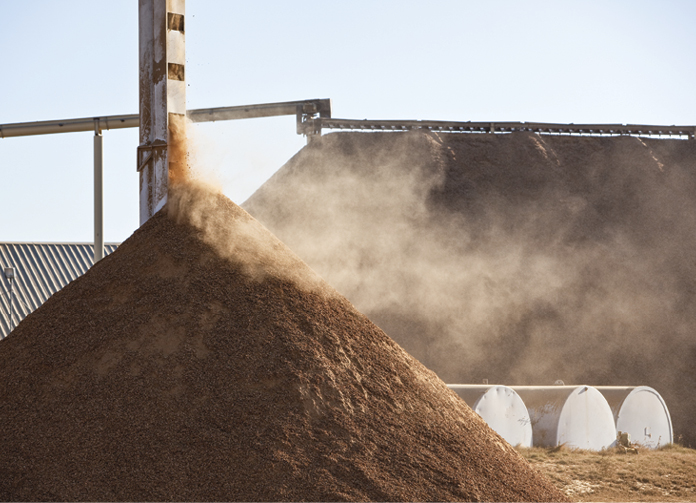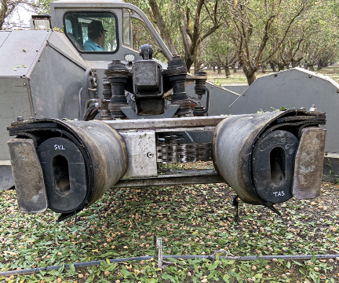Farm waste finds a future in rubber, sugar and more


By Kathy Coatney
Finding uses for agricultural byproducts can be an uphill battle, particularly when that hill is piled high with thousands of tons of hulls and shells left after harvest in California’s $5 billion almond sector.
At one point, those almond shells were worth $40 a ton, but not any longer. Currently, some companies are having to pay $20 a ton just to get rid of them.
That has led the Almond Board of California and the Agricultural Research Service of the U.S. Department of Agriculture to invest in studies to find profitable new uses for almond shells. It’s part of a wider research effort to repurpose agricultural byproducts, from almond biomass to rice and wheat straw to fruit residue.
For the almond shells, there already may be many options. For example, almond shells have been used in manufacturing car parts. The shells are burned at 200 to 300 degrees and made into charcoal.
“We’re doing the char to make carbon black substitutes,” said Bill Orts, USDA research leader for bioproducts.
He said almond shells have also been used in making pallets and are being added to rubber compounds, including for almond harvesting machinery.
“We worked with an almond producer to take torrefied almond shells and use it in the carbon black for an almond tree bumper,” said Orts.
He said the almond-shell rubber product is used for shaker pad bumpers on harvesters. The pads, which help protect trees during harvest, have to be changed frequently. Thus, there is high demand for replacements.
“We did a whole line of bumpers,” Orts said, adding that the production of the pads is due to scale up.
Meanwhile, Orts is also working on turning almond hulls into sugars. “We have a pretty good extraction method for getting the sugars out, and we have fed those sugars in bee diets for overwintering,” he said.
Most of the bee diets have high fructose corn syrup, but bees don’t really love it, or thrive on it, Orts said.
In a project with the Carl Hayden Bee Research Center in Tucson, Arizona, bees were fed samples of almond hull sugar. They loved it, Orts said.
The hulls are quite bitter, so researchers have also been working on removing the harsh tannins. “We took natural proteins and tried to take those bitter tannins out and did,” Orts said, adding the next step is scaling it up.
When the sugar is squeezed out of hulls, it makes a peat moss that also can be used in growing mushrooms. Typically, mushroom growers import sphagnum peat moss from Ireland, Russia and Canada, but it’s expensive, and some countries aren’t allowing it to be exported.
The research essentially worked, but squeezing sugar out just for the mushrooms isn’t feasible, Orts said. Researchers also are uncertain about how to scale up production, he added.
The almond board said it has invested $2 million “in the search for more outlets and value-add options for hulls and shells.” According to 2020 crop year statistics, California’s almond harvest produced 1.9 billion pounds of shells, 4.8 billion pounds of hulls and 4.3 billion pounds of woody biomass.
“Finding more value for hulls, shells and woody biomass is critical to the profitability and sustainability of our industry,” the almond board’s Chief Scientific Officer Josette Lewis said in a report last year.
Orts and other researchers are also working on repurposing other agricultural byproducts, with mixed results. He said researchers have attempted to convert another byproduct, rice straw, into ethanol. That effort was unsuccessful, Orts said.
“Rice straw is 15% to 20% silica, and it really is grit,” he added. “It is exactly as bad as it sounds—little sand particles. Who wants that? Nobody. It beats up your mill; your grinding equipment. It’s a waste product.”
Then again, Orts said, “If you’re making glass or you’re going to make some silicon chips, theoretically, you could take the silica from rice straw and have a good source of silica.”
Orts said hemp may be a better option than rice straw, adding, “Hemp is a much better fiber, and we know how to handle hemp, and it doesn’t have all that silicon.”
Yanyun Zhao, a professor at the Department of Food Science and Technology at Oregon State University, is working on using agricultural and food processing byproducts to create sustainable molded pulp packaging materials.
“What we’ve been doing is to use things we call fiber-rich byproducts,” Zhao said, adding that the fribrous materials are used in compostable packaging.
Zhao’s research team takes the pomace from a variety of fruits, vegetables and winegrapes. She said almost any byproduct can be used so long as it has a high cellulosic fiber content. The pomace is the bioproduct after the juice is compressed, and it has lots of cellulosic fiber. Cellulosic fiber is key for making this type of compostable packaging.
A patent was granted last August, and researchers have built their own pilot-scale molded pulp machine.
“What we can do now is make the plant pot,” Zhao said, adding what makes this process unique is going from raw materials to a finished product in a pilot plant.
“We’re been continuously improving the technology because we want to make all types of packaging,” Zhao said. “The plant pot is just one, so we do want to make a different type of packaging, and we want to include additional agriculture byproducts.”
Each agricultural byproduct has different fiber composition and characteristics, so it requires continuous research, Zhao said.
Agricultural waste such as rice or wheat straw can also be used, Zhao said. “Our ongoing research has really expanded to other ag and food waste,” she added.
Zhao said she plans to continue researching to create different types of packaging because varieties such as food takeout clamshells or tray packaging may have different requirements.
“There’s no one solution that fits all,” Zhao said. “That’s why we want to continue that work to expand the application and improve the technology.”
(Kathy Coatney is a reporter in Bend, Oregon. She may be contacted at kacoatney@gmail.com.)




